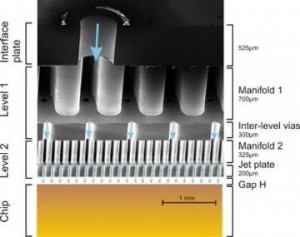Norlux is not doubt a good innovation in cooling technique for super high power LED lights. However, everything has its defects. Using PCBs with aluminum layers can improve the heat radiating performance and also increase the LEDs output power. But PCBs are not good heat conductors. Choosing right PCB materials is still a key point to LED cooling technique.

Cooling design after PCBs:
Heat generated by LED High Bay chips can be transmitted to PCBs. If we do nothing about it, having them contact with the air directly, this will dramatically reduce the thermal radiation. The simplest way is installing additional cooling fins on both sides of PCBs and using fans to enhance the convection of the air. On one hand, it can expand the area of interfaces. On the other hand, it can speed up the heat radiation process. However, this method is only suitable for LED chips with lower heat flux. In recent years, scientists also invented many other after-PCBs cooling techniques, some of which are typically for super high power LED lights.
- Several new designed heat sinks can further improve the heat radiating performance. For instance, some LED manufacturers decided to applied needle-shape heat sink at the back of PCBs. This design dramatically increases the interface between PCBs and the air.
- Some designers preferred to use micro heat pipes to help radiating heat. This is a new design concept for LED cooling system. Heat pipe technology was born in 1963 in Los Alamos National Laboratory in America, designed by George Grover. As a type of thermo-element, heat pipes can strengthen the heat radiation though phase change. Heat pipes have even higher thermal conductivity than metals also much lighter than them. They can be used for long-distance and narrow-space heat radiation. Thus once produced, heat pipes were widely used in vehicle LED STREET applications.
- Synthetic micro-spraying technology. This technology can change the surrounding air pressure though membrane vibration and consequently form jet. Once the vibration frequency within the range of 100Hz – 200Hz, the speed of the jet can reach up to 30 m/s. In terms of air cooling technique, the cooling effect of synthetic micro-spraying technology is 2-3 times as much as that of ordinary fans, while only consumes half energy than them. However, the cost of this sophisticated technology is too high and the entire cooling concept is too complicated, that so far it has not been widely used in LED lighting area.
